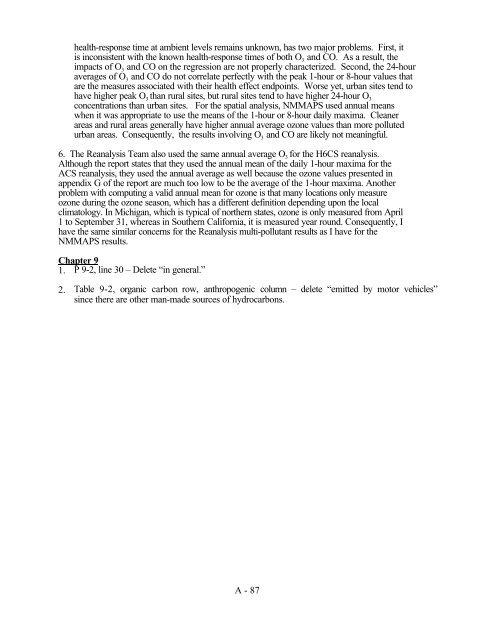Review of the Air Quality Criteria Document for Particulate Matter
Review of the Air Quality Criteria Document for Particulate Matter
Review of the Air Quality Criteria Document for Particulate Matter
- No tags were found...
Create successful ePaper yourself
Turn your PDF publications into a flip-book with our unique Google optimized e-Paper software.
health-response time at ambient levels remains unknown, has two major problems. First, itis inconsistent with <strong>the</strong> known health-response times <strong>of</strong> both O 3 and CO. As a result, <strong>the</strong>impacts <strong>of</strong> O 3 and CO on <strong>the</strong> regression are not properly characterized. Second, <strong>the</strong> 24-houraverages <strong>of</strong> O 3 and CO do not correlate perfectly with <strong>the</strong> peak 1-hour or 8-hour values thatare <strong>the</strong> measures associated with <strong>the</strong>ir health effect endpoints. Worse yet, urban sites tend tohave higher peak O 3 than rural sites, but rural sites tend to have higher 24-hour O 3concentrations than urban sites. For <strong>the</strong> spatial analysis, NMMAPS used annual meanswhen it was appropriate to use <strong>the</strong> means <strong>of</strong> <strong>the</strong> 1-hour or 8-hour daily maxima. Cleanerareas and rural areas generally have higher annual average ozone values than more pollutedurban areas. Consequently, <strong>the</strong> results involving O 3 and CO are likely not meaningful.6. The Reanalysis Team also used <strong>the</strong> same annual average O 3 <strong>for</strong> <strong>the</strong> H6CS reanalysis.Although <strong>the</strong> report states that <strong>the</strong>y used <strong>the</strong> annual mean <strong>of</strong> <strong>the</strong> daily 1-hour maxima <strong>for</strong> <strong>the</strong>ACS reanalysis, <strong>the</strong>y used <strong>the</strong> annual average as well because <strong>the</strong> ozone values presented inappendix G <strong>of</strong> <strong>the</strong> report are much too low to be <strong>the</strong> average <strong>of</strong> <strong>the</strong> 1-hour maxima. Ano<strong>the</strong>rproblem with computing a valid annual mean <strong>for</strong> ozone is that many locations only measureozone during <strong>the</strong> ozone season, which has a different definition depending upon <strong>the</strong> localclimatology. In Michigan, which is typical <strong>of</strong> nor<strong>the</strong>rn states, ozone is only measured from April1 to September 31, whereas in Sou<strong>the</strong>rn Cali<strong>for</strong>nia, it is measured year round. Consequently, Ihave <strong>the</strong> same similar concerns <strong>for</strong> <strong>the</strong> Reanalysis multi-pollutant results as I have <strong>for</strong> <strong>the</strong>NMMAPS results.Chapter 91. P 9-2, line 30 – Delete “in general.”2. Table 9-2, organic carbon row, anthropogenic column – delete “emitted by motor vehicles”since <strong>the</strong>re are o<strong>the</strong>r man-made sources <strong>of</strong> hydrocarbons.A - 87
















